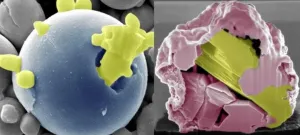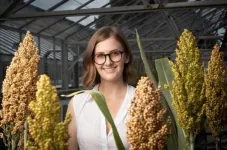(Press-News.org) AMES, Iowa - Inspired by nature's work to build spiky structures in caves, engineers at Iowa State University have developed technology capable of recovering pure and precious metals from the alloys in our old phones and other electrical waste.
Using controlled applications of oxygen and relatively low temperatures, the engineers say they can dealloy a metal by slowly moving the most reactive components to the surface where they form stalagmite-like spikes of metal oxides.
That leaves the least-reactive components in a purified, liquid core surrounded by brittle metal-oxide spikes "to create a so-called 'ship-in-a-bottle structure,'" said Martin Thuo, the leader of the research project and an associate professor of materials science and engineering at Iowa State University.
"The structure formed when the metal is molten is analogous to filled cave structures such as stalactites or stalagmites," Thuo said. "But instead of water, we are using oxidation to create these structures."
A paper describing the new technology, "Passivation-driven speciation, dealloying and purification," has recently been published by the journal Materials Horizons. (See sidebar for the paper's co-authors.)
University startup funds and part of a U.S. Department of Energy Small Business Innovation Research grant supported development of the technology.
Thuo noted this project is the exact opposite of his research group's previous work to develop heat-free solder.
"With heat-free solder, we wanted to put things together," he said. "With this, we want to make things fall apart."
But not just fall apart any which way. Thuo and the engineers in his research group want to control exactly how and where alloy components fall apart, or dealloy.
"It's like being a metal whisperer," he said. "We make things go the way we want."
The engineers offered a more precise description in their paper: "This work demonstrates the controlled behavior of surface oxidation in metals and its potential in design of new particle structures or purification/dealloying. By tuning oxidation via temperature, oxidant partial pressure, time and composition, a balance between reactivity and thermal deformation enables unprecedented morphologies."
Those unprecedented forms and structures could be very useful.
"We need new methods to recover precious metals from e-waste or mixed metal materials," Thuo said. "What we demonstrate here is that the traditional electrochemical or high-temperature methods (above 1,832 degrees Fahrenheit) may not be necessary in metal purification as the metal's reactivity can be used to drive separation."
Thuo said the oxidation technology works well at temperatures of 500 to 700 degrees Fahrenheit. ("This is set in an oven and getting metals to separate," he said.)
Besides metal purification and recovery, this new idea could also be applied to metal speciation - the ability to dictate creation and distribution of certain metal components. One use could be production of complex catalysts to drive multi-stage reactions.
Let's say chemists need a tin oxide catalyst followed by a bismuth oxide catalyst. They'll start with an alloy with the bismuth oxide buried beneath the tin oxide. They'll run the reaction with the tin oxide catalyst. Then they'll raise the temperature to the point that the bismuth oxide comes to the surface as spikes. And then they'll run the reaction with the bismuth oxide catalyst.
Thuo credits development of the new technology to working with talented students and two collaborators.
"We built on this big idea very slowly," he said. "And working together, we were able to break into this knowledge gap."
INFORMATION:
The collaborators/co-authors
Martin Thuo, an associate professor of materials science and engineering at Iowa State University, is the project leader and the paper's corresponding author. Collaborators and co-authors are:
Andrew Martin, an Iowa State graduate with a doctorate in materials science and engineering who's now at the Lawrence Berkeley National Laboratory
Boyce Chang, an Iowa State graduate with a doctorate in materials science and engineering who's now at the University of California Berkeley
Joel Cutinho, an Iowa State graduate with a master's degree in materials science and engineering who now works for Nanolab Technologies
Liyang Shen, an Iowa State doctoral student in chemical and biological engineering
Thomas Ward, an associate professor of aerospace engineering, who contributed work in mass transport
Eric Cochran, a professor of chemical and biological engineering, who contributed work in X-ray diffraction and characterization
Read the paper
"Passivation-driven speciation, dealloying and purification," Materials Horizons, published online Jan. 19, 2021,
https://doi.org/10.1039/D0MH01832E
A type of ultrasound scan can detect cancer tissue left behind after a brain tumour is removed more sensitively than surgeons, and could improve the outcome from operations, a new study suggests.
The new ultrasound technique, called shear wave elastography, could be used during brain surgery to detect residual cancerous tissue, allowing surgeons to remove as much as possible.
Researchers believe that the new type of scan, which is much faster to carry out and more affordable than 'gold standard' MRI scans, has the potential to reduce a patient's risk of relapse by cutting the chances that a tumour will grow ...
The amount of green space surrounding children's homes could be important for their risk of developing ADHD. This is shown by new research results from iPSYCH.
A team of researchers from Aarhus University has studied how green space around the residence affects the risk of children and adolescents being diagnosed with ADHD. And the researchers find an association.
"Our findings show that children who have been exposed to less green surroundings in their residential area in early childhood, which we define as lasting up until age five, have an increased risk of receiving an ADHD diagnosis when compared to children who have been surrounded by the highest level of green space," says ...
Anorexia nervosa, bulimia nervosa and binge-eating disorder are the three main eating disorders that 4 out of in 10 individuals living in Western Europe will experience at some point in their lives. In recent years, studies on the genetic basis of anorexia nervosa have highlighted the existence of predisposing genetic markers, which are shared with other psychiatric disorders. By analysing the genome of tens of thousands of British people, a team from the University of Geneva (UNIGE), the University Hospitals of Geneva (HUG), King's College London, the University College London, the University of North Carolina (UNC) and The Icahn ...
Research from the University of Kent has led to the development of the MeshCODE theory, a revolutionary new theory for understanding brain and memory function. This discovery may be the beginning of a new understanding of brain function and in treating brain diseases such as Alzheimer's.
In a paper published by Frontiers in Molecular Neuroscience, Dr Ben Goult from Kent's School of Biosciences describes how his new theory views the brain as an organic supercomputer running a complex binary code with neuronal cells working as a mechanical computer. He explains ...
Gene editing technology will play a vital role in climate-proofing future crops to protect global food supplies, according to scientists at The University of Queensland.
Biotechnologist Dr Karen Massel from UQ's Centre for Crop Science has published a review of gene editing technologies such as CRISPR-Cas9 to safeguard food security in farming systems under stress from extreme and variable climate conditions.
"Farmers have been manipulating the DNA of plants using conventional breeding technologies for millennia, and now with new gene-editing technologies, we can do this with unprecedented safety, precision and speed," Dr Massel said.
"This type of gene editing mimics the way cells repair in nature."
Her review recommended ...
New research from the University of Kent reveals social cohesion with immigration is best ensured through childhood exposure to diversity in local neighbourhoods, leading to acceptance of other groups.
The research, which is published in Oxford Economic Papers, builds on the Nobel Laureate economist Thomas Schelling's Model of Segregation, which showed that a slight preference by individuals and families towards their own groups can eventually result in complete segregation of communities.
Shedding new light on this issue, researchers from Kent's School of Economics have introduced the theory ...
Will we enjoy our work more once routine tasks are automated? - Not necessarily, suggests a recent study
Research conducted at Åbo Akademi University suggests that when routine work tasks are being replaced with intelligent technologies, the result may be that employees no longer experience their work as meaningful.
Advances in new technologies such as artificial intelligence, robotics and digital applications have recently resurrected discussions and speculations about the future of working life. Researchers predict that new technologies will affect, in particular, routine and structured work tasks. According to estimations, 7-35 percent ...
Home Office data shows the number of police officers voluntarily resigning from the force in England and Wales has more than doubled in the last eight years.
Scant attention has been paid to the reason for this mass exodus. Until now. Researchers from the University of Portsmouth studied government statistics, and discovered the numbers of officers voluntarily resigning from the police service is rising - from 1,158 in the year ending March 2012 to 2,363 in the year ending March 2020. The figure amounts to 1.83 per cent of the total police officer population in England and Wales up from 0.86 per cent eight years ago.
Dr Sarah Charman, from the Institute of Criminal Justice Studies at the University of Portsmouth, led the study. ...
New research will enhance corona safety during cruises and help cruise lines to again attract passengers onboard
Researchers within Cell Biology and Industrial Management at Åbo Akademi University have developed models aimed at ensuring corona safety during cruises.
The coronavirus pandemic stopped the cruise industry more or less completely. Major international cruise lines, such as Royal Caribbean Group and Carnival Corporation, largely suspended their cruises during 2020, which resulted in practically zero turnover and losses amounting to billions.
Upon assignment by Business Finland, an interdisciplinary research team has been working to find solutions for managing the current crisis ...
A lot of us recycle our old textiles, but few of us know that they are very difficult to re-use, and often end up in landfills anyway. Now, researchers at Lund University in Sweden have developed a method that converts cotton into sugar, that in turn can be turned into spandex, nylon or ethanol.
WATCH: New method transforms old cotton into glucose
https://www.youtube.com/watch?v=B1V--prLs08
Every year, an estimated 25 million tonnes of cotton textiles are discarded around the world. In total, 100 million tonnes of textiles are thrown out. In Sweden, most of the material goes straight into an incinerator and becomes district heating. In other places, it is even worse, as clothes usually end up in landfills.
"Considering that cotton is a renewable ...

